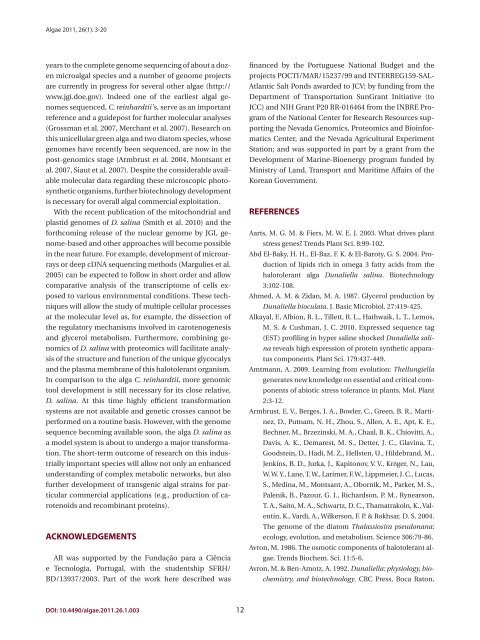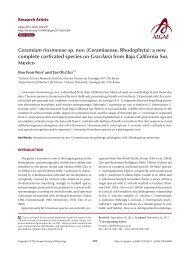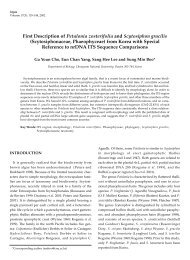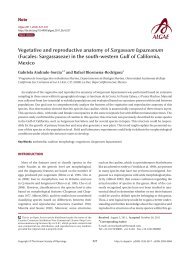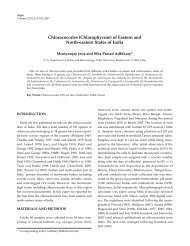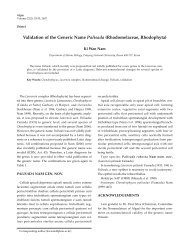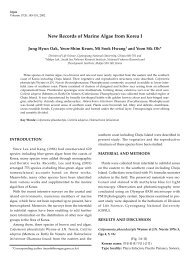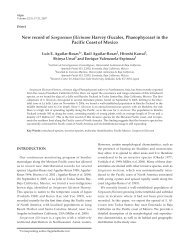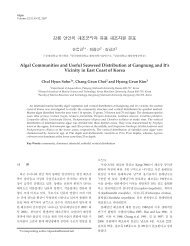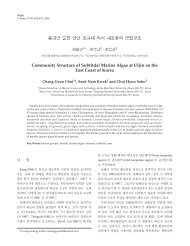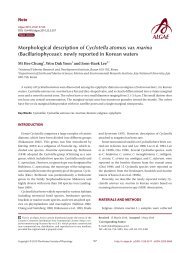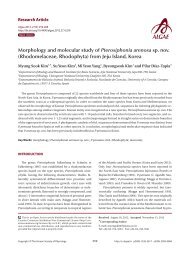The unicellular green alga Dunaliella salina Teod. as a model - Algae
The unicellular green alga Dunaliella salina Teod. as a model - Algae
The unicellular green alga Dunaliella salina Teod. as a model - Algae
Create successful ePaper yourself
Turn your PDF publications into a flip-book with our unique Google optimized e-Paper software.
<strong>Algae</strong> 2011, 26(1): 3-20<br />
years to the complete genome sequencing of about a dozen<br />
micro<strong>alga</strong>l species and a number of genome projects<br />
are currently in progress for several other <strong>alga</strong>e (http://<br />
www.jgi.doe.gov). Indeed one of the earliest <strong>alga</strong>l genomes<br />
sequenced, C. reinhardtii’s, serve <strong>as</strong> an important<br />
reference and a guidepost for further molecular analyses<br />
(Grossman et al. 2007, Merchant et al. 2007). Research on<br />
this <strong>unicellular</strong> <strong>green</strong> <strong>alga</strong> and two diatom species, whose<br />
genomes have recently been sequenced, are now in the<br />
post-genomics stage (Armbrust et al. 2004, Montsant et<br />
al. 2007, Siaut et al. 2007). Despite the considerable available<br />
molecular data regarding these microscopic photosynthetic<br />
organisms, further biotechnology development<br />
is necessary for overall <strong>alga</strong>l commercial exploitation.<br />
With the recent publication of the mitochondrial and<br />
pl<strong>as</strong>tid genomes of D. <strong>salina</strong> (Smith et al. 2010) and the<br />
forthcoming rele<strong>as</strong>e of the nuclear genome by JGI, genome-b<strong>as</strong>ed<br />
and other approaches will become possible<br />
in the near future. For example, development of microarrays<br />
or deep cDNA sequencing methods (Margulies et al.<br />
2005) can be expected to follow in short order and allow<br />
comparative analysis of the transcriptome of cells exposed<br />
to various environmental conditions. <strong>The</strong>se techniques<br />
will allow the study of multiple cellular processes<br />
at the molecular level <strong>as</strong>, for example, the dissection of<br />
the regulatory mechanisms involved in carotenogenesis<br />
and glycerol metabolism. Furthermore, combining genomics<br />
of D. <strong>salina</strong> with proteomics will facilitate analysis<br />
of the structure and function of the unique glycocalyx<br />
and the pl<strong>as</strong>ma membrane of this halotolerant organism.<br />
In comparison to the <strong>alga</strong> C. reinhardtii, more genomic<br />
tool development is still necessary for its close relative,<br />
D. <strong>salina</strong>. At this time highly efficient transformation<br />
systems are not available and genetic crosses cannot be<br />
performed on a routine b<strong>as</strong>is. However, with the genome<br />
sequence becoming available soon, the <strong>alga</strong> D. <strong>salina</strong> <strong>as</strong><br />
a <strong>model</strong> system is about to undergo a major transformation.<br />
<strong>The</strong> short-term outcome of research on this industrially<br />
important species will allow not only an enhanced<br />
understanding of complex metabolic networks, but also<br />
further development of transgenic <strong>alga</strong>l strains for particular<br />
commercial applications (e.g., production of carotenoids<br />
and recombinant proteins).<br />
ACKNOWLEDGEMENTS<br />
AR w<strong>as</strong> supported by the Fundação para a Ciência<br />
e Tecnologia, Portugal, with the studentship SFRH/<br />
BD/13937/2003. Part of the work here described w<strong>as</strong><br />
DOI: 10.4490/<strong>alga</strong>e.2011.26.1.003 12<br />
financed by the Portuguese National Budget and the<br />
projects POCTI/MAR/15237/99 and INTERREG159-SAL-<br />
Atlantic Salt Ponds awarded to JCV; by funding from the<br />
Department of Transportation SunGrant Initiative (to<br />
JCC) and NIH Grant P20 RR-016464 from the INBRE Program<br />
of the National Center for Research Resources supporting<br />
the Nevada Genomics, Proteomics and Bioinformatics<br />
Center, and the Nevada Agricultural Experiment<br />
Station; and w<strong>as</strong> supported in part by a grant from the<br />
Development of Marine-Bioenergy program funded by<br />
Ministry of Land, Transport and Maritime Affairs of the<br />
Korean Government.<br />
REFERENCES<br />
Aarts, M. G. M. & Fiers, M. W. E. J. 2003. What drives plant<br />
stress genes? Trends Plant Sci. 8:99-102.<br />
Abd El-Baky, H. H., El-Baz, F. K. & El-Baroty, G. S. 2004. Pro-<br />
duction of lipids rich in omega 3 fatty acids from the<br />
halotolerant <strong>alga</strong> <strong>Dunaliella</strong> <strong>salina</strong>. Biotechnology<br />
3:102-108.<br />
Ahmed, A. M. & Zidan, M. A. 1987. Glycerol production by<br />
<strong>Dunaliella</strong> bioculata. J. B<strong>as</strong>ic Microbiol. 27:419-425.<br />
Alkayal, F., Albion, R. L., Tillett, R. L., Hathwaik, L. T., Lemos,<br />
M. S. & Cushman, J. C. 2010. Expressed sequence tag<br />
(EST) profiling in hyper saline shocked <strong>Dunaliella</strong> sali-<br />
na reveals high expression of protein synthetic appara-<br />
tus components. Plant Sci. 179:437-449.<br />
Amtmann, A. 2009. Learning from evolution: <strong>The</strong>llungiella<br />
generates new knowledge on essential and critical com-<br />
ponents of abiotic stress tolerance in plants. Mol. Plant<br />
2:3-12.<br />
Armbrust, E. V., Berges, J. A., Bowler, C., Green, B. R., Marti-<br />
nez, D., Putnam, N. H., Zhou, S., Allen, A. E., Apt, K. E.,<br />
Bechner, M., Brzezinski, M. A., Chaal, B. K., Chiovitti, A.,<br />
Davis, A. K., Demarest, M. S., Detter, J. C., Glavina, T.,<br />
Goodstein, D., Hadi, M. Z., Hellsten, U., Hildebrand, M.,<br />
Jenkins, B. D., Jurka, J., Kapitonov, V. V., Kröger, N., Lau,<br />
W. W. Y., Lane, T. W., Larimer, F. W., Lippmeier, J. C., Luc<strong>as</strong>,<br />
S., Medina, M., Montsant, A., Obornik, M., Parker, M. S.,<br />
Palenik, B., Pazour, G. J., Richardson, P. M., Rynearson,<br />
T. A., Saito, M. A., Schwartz, D. C., Thamatrakoln, K., Val-<br />
entin, K., Vardi, A., Wilkerson, F. P. & Rokhsar, D. S. 2004.<br />
<strong>The</strong> genome of the diatom Thal<strong>as</strong>siosira pseudonana:<br />
ecology, evolution, and metabolism. Science 306:79-86.<br />
Avron, M. 1986. <strong>The</strong> osmotic components of halotolerant al-<br />
gae. Trends Biochem. Sci. 11:5-6.<br />
Avron, M. & Ben-Amotz, A. 1992. <strong>Dunaliella</strong>: physiology, bio-<br />
chemistry, and biotechnology. CRC Press, Boca Raton,


